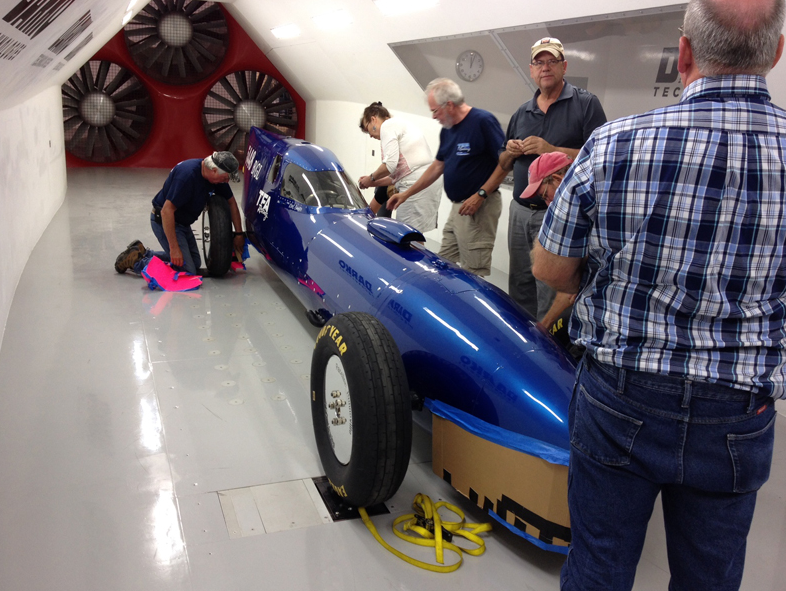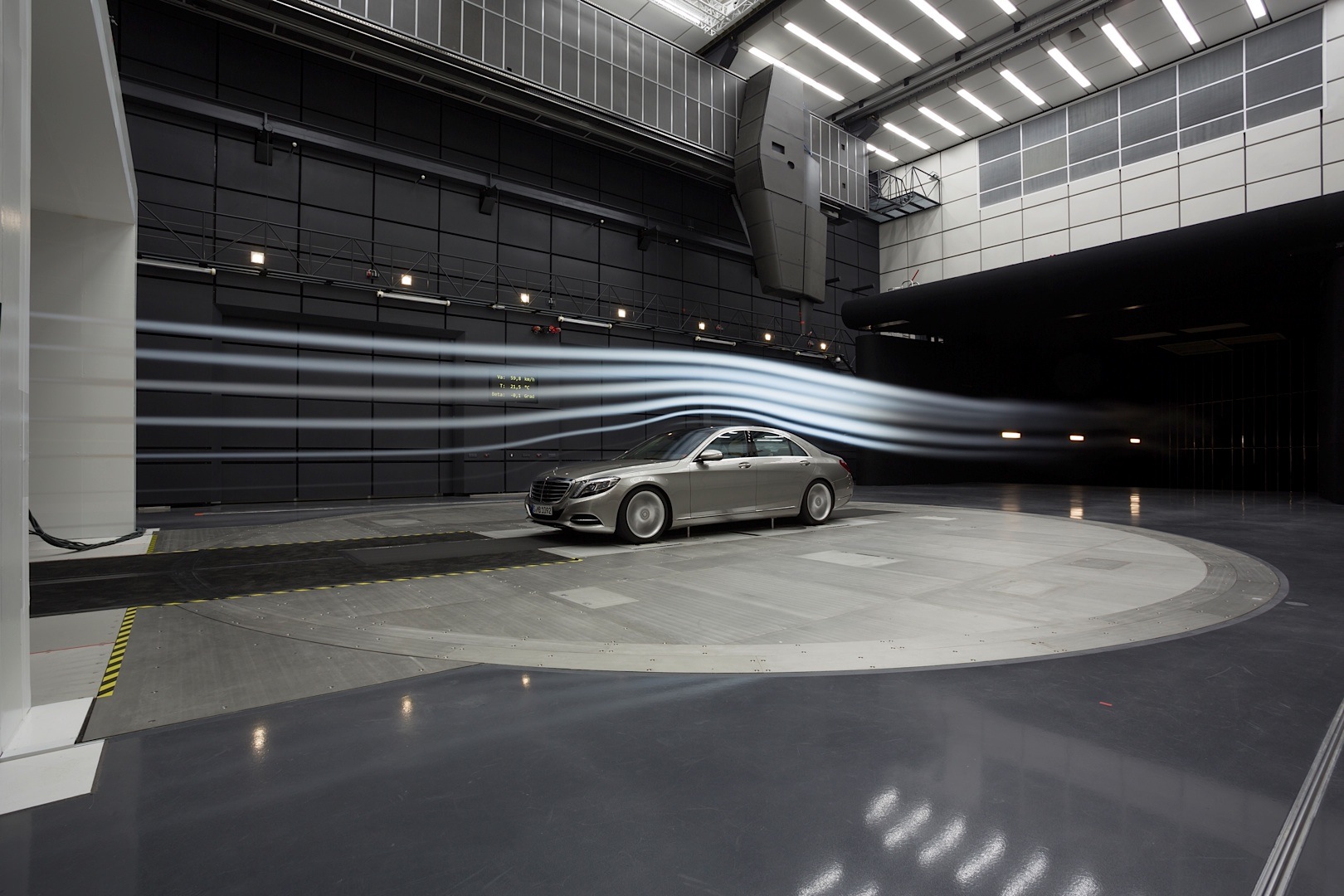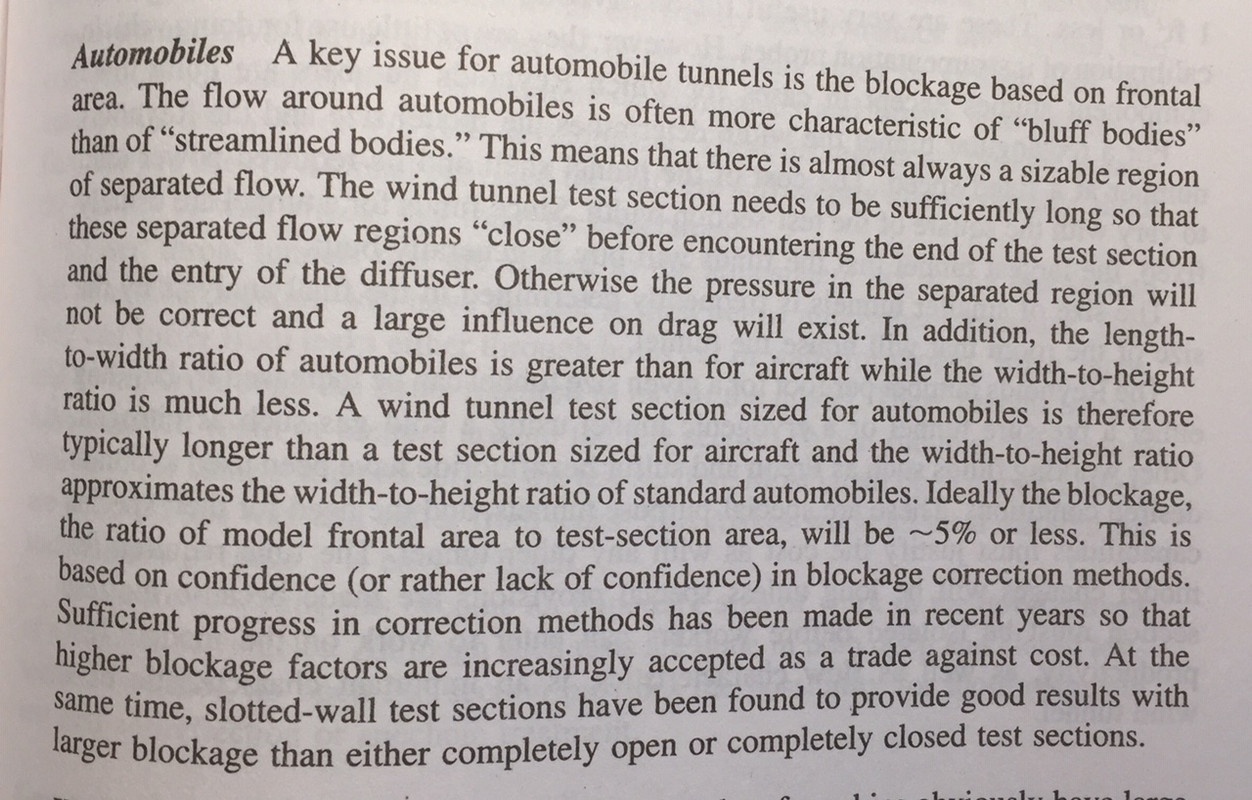 08-28-2020, 01:04 PM
08-28-2020, 01:04 PM
|
#1 (permalink)
|
|
Master EcoModder
Join Date: Jan 2008
Location: Sanger,Texas,U.S.A.
Posts: 16,534
Thanks: 24,520
Thanked 7,436 Times in 4,817 Posts
|
Contour-corrupted rooflines and lift
Since this subject has come up I wanted to share one tid-bit of data, actually quite rare in the popular press.
--------------------------------------------------------------------------------------
In 2014, CAR and DRIVER tested a 2014 Cadillac CTS VSPORT at the A2 Wind Tunnel.
When compared to the 'template,' the roof contour of the Caddy strays a bit, going hypo-contour for a smidgeon, then recovers at the decklid trailing edge.
Any flow instability due to the 'off the reservation' flow would be sequestered atop the backlight and boot, isolated to that region.
At 100- mph ( 161 km/h ) the VSPORT developed 30.6-pounds of rear lift, and 40.8-pounds front lift.
The curb weight is 3,998-pounds. EPA test weight would be 4298-pounds.
A gross, plan-view, 'wing area' is 98.02 square-feet. Gravitational wing loading = 43.1 pounds/ square-foot.
Aerodynamic loading is negative 0.72-pounds / square-foot at 100-mph.
At 100-mph, the VSPORT experiences 98.3% of it's static wheel loading.
As a 'wing', and with a plan-view Coefficient of Lift = 0.00007284227709, 'take-off' velocity for the car, at Le Mans, on the Mulsanne Straight, would be 776 - mph. Supersonic.
As someone who was born yesterday, and just fell off the turnip truck, I'm inclined not to concern myself with the 'lift' of production vehicles, as was the habit of Hucho when he published his second- edition.
I'm especially inclined not to concern myself with vehicles who's rooflines resemble the streamline profile.
Spirit was essentially zero-lift at DARKO. Hoerner has published pressure profile data for streamlined cars which clearly demonstrate positive loading at nose and tail, cancelling any lift in between.
I'm compiling a list of contour-corrupted fastback cars which would suffer separation- induced lift, some of which are in production today. I'll add that as a near-future addendum.
I anticipate push-back, from a certain gentleman in Australia, who, no doubt will completely discount the validity of the DARKO and A2 data. All I can offer is, an invitation for him to take every vehicle previously tested, to a moving-road wind tunnel and publish the contrasting data. There exists no other way to defend criticism of extant data.
__________________
Photobucket album: http://s1271.photobucket.com/albums/jj622/aerohead2/
Last edited by aerohead; 08-28-2020 at 01:08 PM..
Reason: add text
|
|
|

|
 Today Today
|
|
|
|
 Other popular topics in this forum...
Other popular topics in this forum...
|
|
|
|
 08-28-2020, 06:55 PM
08-28-2020, 06:55 PM
|
#2 (permalink)
|
|
Banned
Join Date: Nov 2017
Location: Australia
Posts: 2,060
Thanks: 107
Thanked 1,608 Times in 1,137 Posts
|
Quote:
Originally Posted by aerohead

I anticipate push-back, from a certain gentleman in Australia, who, no doubt will completely discount the validity of the DARKO and A2 data.
|
A2 wind tunnel:

Darko:

Mercedes wind tunnel:

I suggest people look up 'wind tunnel blockage factor' and then make your own judgement. Basically, car manufacturers, F1 teams (etc) don't build huge wind tunnels because they just like spending money.
|
|
|

|
|
The Following 2 Users Say Thank You to JulianEdgar For This Useful Post:
|
|
 08-28-2020, 07:00 PM
08-28-2020, 07:00 PM
|
#3 (permalink)
|
|
Banned
Join Date: Nov 2017
Location: Australia
Posts: 2,060
Thanks: 107
Thanked 1,608 Times in 1,137 Posts
|
Quote:
Originally Posted by aerohead

When compared to the 'template,' the roof contour of the Caddy strays a bit, going hypo-contour for a smidgeon, then recovers at the decklid trailing edge.
Any flow instability due to the 'off the reservation' flow would be sequestered atop the backlight and boot, isolated to that region.
|
I am afraid this is just gibberish.
What does 'hypo-contour' mean?
What is 'off the reservation flow'?
What does 'sequestered' mean?
And what is 'contour corrupted'? (title of thread)
To be honest, Aerohead has developed his own weird theory and then has to develop his own vocabulary to describe it. None of this stuff is in any current textbook on car aerodynamics. |
|
|

|
|
The Following User Says Thank You to JulianEdgar For This Useful Post:
|
|
 08-28-2020, 07:17 PM
08-28-2020, 07:17 PM
|
#4 (permalink)
|
|
Banned
Join Date: Nov 2017
Location: Australia
Posts: 2,060
Thanks: 107
Thanked 1,608 Times in 1,137 Posts
|
And re the Cadillac. It's not a car I am familiar with, but I see a Cd listed of 0.29. From that, you can be pretty confident of attached flow right down to the trailing edge of the boot lid, and from that, you can be pretty confident of a fair amount of rear lift as the air travels around the curve from the roof to the rear window. (I'd be happy to see some smoke stream pics, if anyone can find them.)
If the car develops at 100mph 30.6-pounds of rear lift, and 40.8-pounds front lift, I'll let someone else find the frontal area and do the calculations for the coefficients of front and rear lift. My guess, and it is only that, is that the figures would be quite different in free air (and not a tiny wind tunnel), but even as they are, you can start getting a feel for how car shapes produce lift.
As to Aerohead's calculations, he is either deliberately muddying the water or is confused. No one is expecting the car to fly - yet another strawman argument of the type that Aerohead is so fond of adopting.
|
|
|

|
|
The Following User Says Thank You to JulianEdgar For This Useful Post:
|
|
 08-31-2020, 03:34 PM
08-31-2020, 03:34 PM
|
#5 (permalink)
|
|
Master EcoModder
Join Date: Jul 2011
Location: Ann Arbor, Michigan
Posts: 4,214
Thanks: 143
Thanked 2,827 Times in 1,983 Posts
|
What kind of variations or errors will we see in a small wind tunnel that are not present at the large wind tunnel?
Can these variations be corrected for and adjusted as with polling data?
__________________
George
Architect, Artist and Designer of Objects
2012 Infiniti G37X Coupe
1977 Porsche 911s Targa
1998 Chevy S-10 Pick-Up truck
1989 Scat II HP Hovercraft
You cannot sell aerodynamics in a can............
|
|
|

|
 08-31-2020, 04:44 PM
08-31-2020, 04:44 PM
|
#6 (permalink)
|
|
Banned
Join Date: Nov 2017
Location: Australia
Posts: 2,060
Thanks: 107
Thanked 1,608 Times in 1,137 Posts
|
Quote:
Originally Posted by kach22i

What kind of variations or errors will we see in a small wind tunnel that are not present at the large wind tunnel? Can these variations be corrected for and adjusted as with polling data?
|
I think every single factor that is measurable will likely be in error. 'Low Speed Wind Tunnel Testing (Barlow/Rae/Pope) is the book to look at ('low speed', as in sub-sonic). It has a large number of chapters devoted to corrections.
Here's a key passage from that book relating to wind tunnel test section size:

So yes you can see from this that correction factors exist, but the recommendation (AFAIK) still remains at a max of 5 per cent blockage.
As I said, you can be sure if smaller, cheaper wind tunnels were fine, car manufacturers, race teams, etc, wouldn't have all built huge (and massively expensive) wind tunnels.
Last edited by JulianEdgar; 08-31-2020 at 05:11 PM..
Reason: typo
|
|
|

|
|
The Following User Says Thank You to JulianEdgar For This Useful Post:
|
|
 09-02-2020, 01:18 PM
09-02-2020, 01:18 PM
|
#7 (permalink)
|
|
Master EcoModder
Join Date: Jan 2008
Location: Sanger,Texas,U.S.A.
Posts: 16,534
Thanks: 24,520
Thanked 7,436 Times in 4,817 Posts
|
blockage ratio
Quote:
Originally Posted by JulianEdgar

A2 wind tunnel:

Darko:

Mercedes wind tunnel:

I suggest people look up 'wind tunnel blockage factor' and then make your own judgement. Basically, car manufacturers, F1 teams (etc) don't build huge wind tunnels because they just like spending money. |
According to Hucho, reliable, zero-yaw numbers have been recorded in tunnels with blockage ratios as high as 30%.
__________________
Photobucket album: http://s1271.photobucket.com/albums/jj622/aerohead2/
|
|
|

|
 09-02-2020, 02:11 PM
09-02-2020, 02:11 PM
|
#8 (permalink)
|
|
Master EcoModder
Join Date: Jan 2008
Location: Sanger,Texas,U.S.A.
Posts: 16,534
Thanks: 24,520
Thanked 7,436 Times in 4,817 Posts
|
gibberish
Quote:
Originally Posted by JulianEdgar

I am afraid this is just gibberish.
What does 'hypo-contour' mean?
What is 'off the reservation flow'?
What does 'sequestered' mean?
And what is 'contour corrupted'? (title of thread)
To be honest, Aerohead has developed his own weird theory and then has to develop his own vocabulary to describe it. None of this stuff is in any current textbook on car aerodynamics.
|
1) hypo is below contour.
2) off the reservation is off the profile
3) sequestered is, the flow instability (separation bubble ) is captured between the backlight and end of boot,with no chance of making it to the 'base' of the car and contaminating it with low pressure.
4) 'Corrupted' means that the ground rules of fluid mechanics are violated by the shape. The 'template' contour produces laminar flow. By straying off the template contour you jeopardize the boundary layer which is responsible for flow separation, which is responsible for pressure drag.
5) all streamlining has to do with minimizing, or eliminating flow separation.
6) The Cadillac poses only a small perturbation. It's virtual lack of rear lift is a testament to the pressure-producing capability of a streamlined shape.
If you'll revisit Figure 2.4, page 51 of Hucho, you can see how,over the last 14.5% of the body, local pressure rises all the way back to local barometric pressure. Depending on rear overhang, and low pressure under the body, due to a diffuser, rear lift can be zero, like the VSPORT's.
7) In Hoerner's Fig. 9.4 page 160, you can see the Jaray car Sawatzki tested in 1941, with atmospheric pressure acting on the nose, a large pulse of positive pressure acting against the cowl area, then the last 23% of the body under a positive pressure gradient, acting at a distance behind the rear axle, like a wing on an F1/Indycar, or your cantilever spoiler on the Insight.
Sure would be cool if you could get into Bernoulli's Equation and Mair's and Buchheim's work on boat-tailing. Only then will you understand the value of 'corrupting', or what Lanchester referred to as 'mutilating' the streamline body.
Nobody disputes your pressure measurements, but there's an issue with the quality of the body shape you're measuring, as related to boundary layer 'health' that must be addressed. This is where I'm coming from. And it's something your aeronautical engineer and aerodynamicists may have never had to contend with, as 'low drag' may never have been a priority with the legacy carmakers they worked for. Don't know.
The new head of design for Volvo's Polestar Division is having to overcome a lot of institutional inertia with parent Volvo, who's always relied on selling 'emotion', not technology.
__________________
Photobucket album: http://s1271.photobucket.com/albums/jj622/aerohead2/
|
|
|

|
 09-02-2020, 04:39 PM
09-02-2020, 04:39 PM
|
#9 (permalink)
|
|
Banned
Join Date: Nov 2017
Location: Australia
Posts: 2,060
Thanks: 107
Thanked 1,608 Times in 1,137 Posts
|
Quote:
Originally Posted by aerohead

1)
If you'll revisit Figure 2.4, page 51 of Hucho, you can see how,over the last 14.5% of the body, local pressure rises all the way back to local barometric pressure. Depending on rear overhang, and low pressure under the body, due to a diffuser, rear lift can be zero, like the VSPORT's.
|
You do realise that the diagram you nominate is for inviscid flow?
That is, it's for for an imaginary fluid having no viscosity?
You did read the description on the next page that states:
In the real, viscous flow there exists a drag force, but it cannot be explained by considering an ideal, inviscid fluid.
If you are using this diagram - and others with similar concepts - no wonder your theory is so divorced from the reality of car aerodynamics.
Addition:
In fact, for people interested in seeing how confusion (and weird theories) can develop, it's worth having a good read of pages 51 and 52 of Hucho, second edition. It explains really clearly how a simplified aerodynamic model (ie non-viscous fluid) cannot be used to explain what happens on real cars.
Last edited by JulianEdgar; 09-02-2020 at 05:52 PM..
|
|
|

|
|
The Following User Says Thank You to JulianEdgar For This Useful Post:
|
|
 09-04-2020, 11:02 AM
09-04-2020, 11:02 AM
|
#10 (permalink)
|
|
Master EcoModder
Join Date: Jan 2008
Location: Sanger,Texas,U.S.A.
Posts: 16,534
Thanks: 24,520
Thanked 7,436 Times in 4,817 Posts
|
Cadillac
Quote:
Originally Posted by JulianEdgar

And re the Cadillac. It's not a car I am familiar with, but I see a Cd listed of 0.29. From that, you can be pretty confident of attached flow right down to the trailing edge of the boot lid, and from that, you can be pretty confident of a fair amount of rear lift as the air travels around the curve from the roof to the rear window. (I'd be happy to see some smoke stream pics, if anyone can find them.)
If the car develops at 100mph 30.6-pounds of rear lift, and 40.8-pounds front lift, I'll let someone else find the frontal area and do the calculations for the coefficients of front and rear lift. My guess, and it is only that, is that the figures would be quite different in free air (and not a tiny wind tunnel), but even as they are, you can start getting a feel for how car shapes produce lift.
As to Aerohead's calculations, he is either deliberately muddying the water or is confused. No one is expecting the car to fly - yet another strawman argument of the type that Aerohead is so fond of adopting.
|
1) the published drag coefficient is Cd 0.32.
2) the published frontal area is Af 24.5-sq-ft ( 85.078% of gross area )
3) a scaled comparison to the template suggests perfectly attached flow at the decklid spoiler.
4) at 100-mph, the car generates 30.6-pounds of rear lift, retaining 98.3 % of it's static wheel loading.
5) EPA test weight of the car is 4298-pounds.
6) 48 % of weight is borne by the rear axles ( 2063-pounds )
7) at 172-mph, rear lift is 90.52-pounds, compared to 207-pounds for a 1969 Volkswagen 1600 Squareback.
8) Hucho stated, in his 2nd-Edition, that if the car's aft-body trailing edge was simply raised to the elevation of the production spoiler, both lift and drag characteristics would be improved. One can infer what they wish.
9) the fastest posted speed limit in the United States is 85-mph.
10) rear lift on the Cadillac at this velocity is statistically meaningless.
11) it would be less with the template. By default.
__________________
Photobucket album: http://s1271.photobucket.com/albums/jj622/aerohead2/
Last edited by aerohead; 09-04-2020 at 11:04 AM..
Reason: typo
|
|
|

|
|